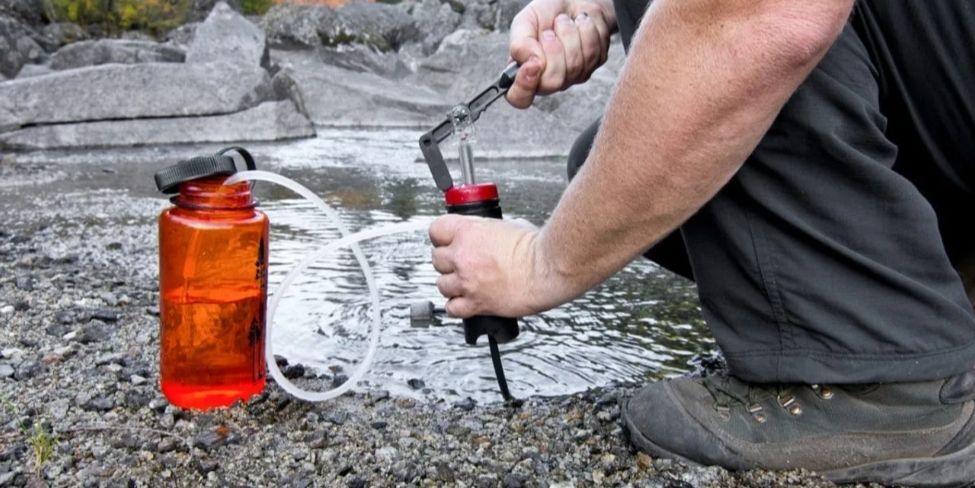Do you need to filter river water? Don't know how to filter river water effectively?
The answers are in this article!
To purify river water effectively, there's no shortage of ideas, and as you'll see, none of them are really difficult to implement. Each solution has its advantages and disadvantages, which you'll have to come to terms with.
The trick is knowing what kind of solution you're willing to keep with you all the time to be able to make river water drinkable.
The best ways to filter river water are:
- Purifying water by boiling it in a container
- Drink water directly through a filtering straw
- Pump water through a filter
- Purify the water using a UV sterilizer
- Disinfect water with effervescent tablets
- Filtering water with a filtering gourd
Without further ado, let's look one by one at each solution for getting drinking water.
1. Boiling water to purify it

Boiling water is the most effective method for killing all bacteria. Provided the water is clear (filter it with a clean cloth if it's cloudy), simply hold the water at boiling for a few minutes (depending on altitude), let it cool and you're done.
- Below 2000 meters altitude: 1 minute of boiling is enough
- Above 2000 meters altitude: allow a minimum of 3 minutes boiling time
Advantages: No special equipment required. All you need is a campfire or a gas stove and a (fireproof) container to boil the water in.
Disadvantages: You need something to heat (stove, fire) and a container. It also takes time to build a fire and bring water to the boil, this is even more true in altitude. Then the water has to cool down, which also takes time. Unless, of course, you'd like a cup of coffee.
2. Using a survival straw

These filtration compact tools weigh just fifty grams, measure between 15 and 20 cm and can be used anywhere. It's best to use them with a charcoal filter to improve taste.
Advantages: The pailles are lightweight, sturdy, offer good flow (approx. 1.5 liters/minute) and can filter up to 1000 liters depending on the model. What's more, they eliminate up to 99.9999% of waterborne bacteria and 99.9% of waterborne protozoan parasites. A reliable and affordable tool (under €40).
Drawbacks: Impossible to filter water in bulk for cooking with a straw. Water filtration only takes place when you suck in with your mouth. What's more, it doesn't filter out chemicals or toxins.
3. Filtering water with a pump

Hiking filter systems work with a hand pump or thanks to gravity. They are practical, for example, for extended stays or camps. They can be used to fill water bottles or gourds with filtered water.
Benefits: Lightweight, removes bacteria, protozoa,
Disadvantages: The most expensive solution. Depending on their filtering capacity, they can cost from €60 to several hundred euros.
4. Sterilize water with a purifier

Contrary to previous solutions, these tools do not eliminate contaminants, they destroy them, hence their designation: purifiers. Bacteria and other viruses are eliminated by UV light, which disrupts their DNA and renders them incapable of replicating and causing infection.
Benefits: Destroy over 99.9% of harmful microorganisms, including giardiasis, bacteria, viruses and protozoa. The purification is fast, 1 to 2 minutes to treat 1 liter of water.
Disadvantages : Water purifiers are expensive. These are "electronic" objects, so they require a power supply that needs to be recharged, and they are fragile. They're not very effective with turbid water, so some river water needs to be pre-filtered before consumption.
5. Disinfect water with tablets

Disinfection tablets are effective against viruses, bacteria, giardia cyst and cryptosporidiosis. Simply dissolve in water, mix well and leave for 30 minutes.
Benefits: Each tablet can purify up to 20 liters of water and is sold in boxes of 50 or 100 tablets for around €10 to €20. They take up no space, are easy to transport and the water can be stored for several months.
Disadvantages: Some randonneurs aren't comfortable with adding chemicals (mainly effervescent chlorine, sodium and silver) to their water supply. For Grande Randonnée (GR), many prefer filtration or UV sterilization to make their water potable.
6. Drinking water everywhere and all the time with a gourd

The advantages of the previous solutions, without the disadvantages. A drinking bottle with a filtration system like the ÖKO can be used very simply, anywhere, at home or in the wild, and instantly.
Advantages: Immediate water availability: you just fill up and drink. Effective protection against protozoa, viruses and micro-organisms. The taste of the water remains pleasant thanks to activated carbon. Sturdy, shock-resistant design.
Disadvantages: By design, it can only filter the water contained in its gourd, unless you have another bottle to transfer the filtered water inside.
The best way to filter water is the one you have available
We've shown you various ways of making river water drinkable. As you've seen, they all present a certain level of constraint, ranging from specific equipment to carry (pump, stove, pan, etc.), to waiting for boiling (and cooling). Not to mention the use of chemicals or fragile equipment with disinfecting tablets and UV purifiers.
That said, before thinking about making water drinkable, it's good to know what's upstream from where the water is collected. There may be a factory a few kilometers away, or an animal carcass lying half in the water... Before the material, the best filter is yourself.
Then, the best water filter is one you can take anywhere, without restraint or fear of damaging it, and that stands on its own.
The OKO filter water bottle meets all these criteria, being lightweight, sturdy and practical to use every day (even at home).
 Contact us
Contact us
 FREE delivery from £99
FREE delivery from £99
 Delivery in 2-3 days
Delivery in 2-3 days
 Secure payment
Secure payment
 French company
French company

